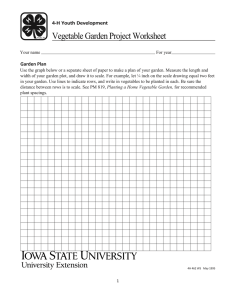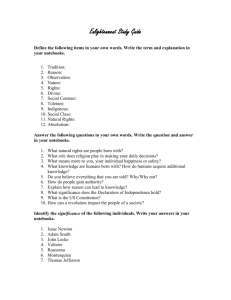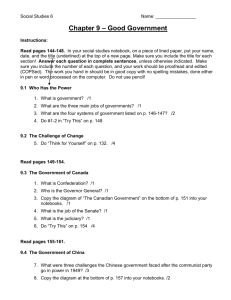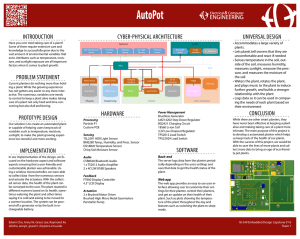Let’s Make Stew! U
advertisement
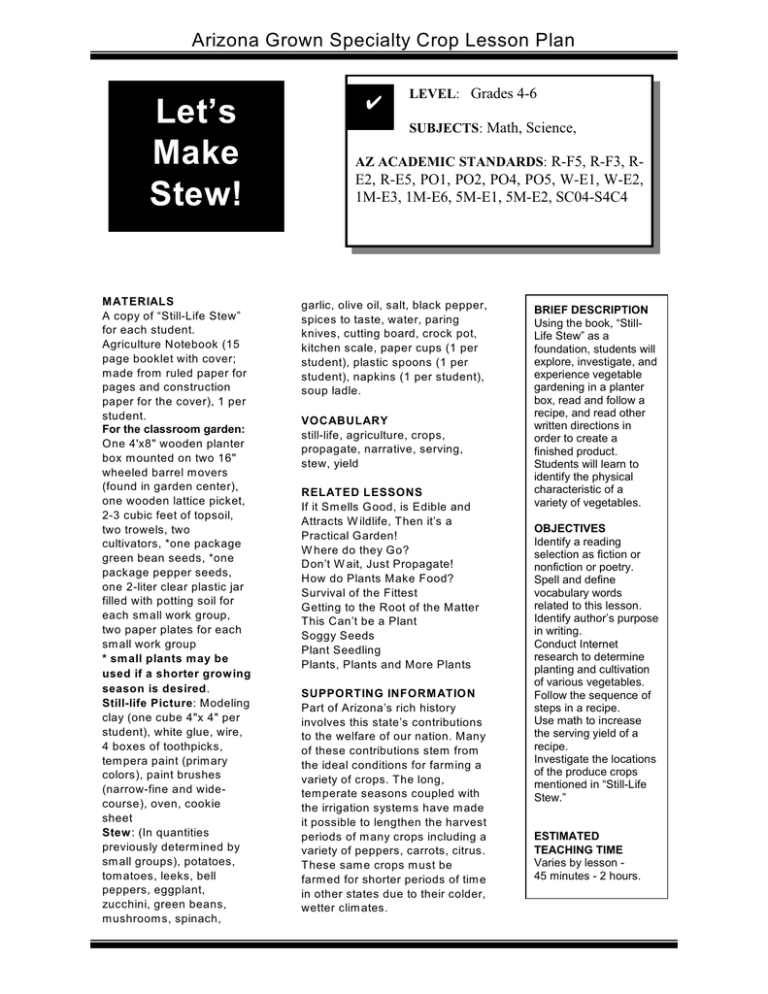
Arizona Grown Specialty Crop Lesson Plan Let’s Make Stew! M ATERIALS A copy of “Still-Life Stew” for each student. Agriculture Notebook (15 page booklet with cover; m ade from ruled paper for pages and construction paper for the cover), 1 per student. For the classroom garden: One 4'x8" wooden planter box m ounted on two 16" wheeled barrel m overs (found in garden center), one wooden lattice picket, 2-3 cubic feet of topsoil, two trowels, two cultivators, *one package green bean seeds, *one package pepper seeds, one 2-liter clear plastic jar filled with potting soil for each sm all work group, two paper plates for each sm all work group * small plants may be used if a shorter growing season is desired. Still-life Picture: Modeling clay (one cube 4"x 4" per student), white glue, wire, 4 boxes of toothpicks, tem pera paint (prim ary colors), paint brushes (narrow-fine and widecourse), oven, cookie sheet Stew : (In quantities previously determ ined by sm all groups), potatoes, tom atoes, leeks, bell peppers, eggplant, zucchini, green beans, m ushroom s, spinach, U LEVEL: Grades 4-6 SUBJECTS: Math, Science, AZ ACADEMIC STANDARDS: R-F5, R-F3, R- E2, R-E5, PO1, PO2, PO4, PO5, W-E1, W-E2, 1M-E3, 1M-E6, 5M-E1, 5M-E2, SC04-S4C4 garlic, olive oil, salt, black pepper, spices to taste, water, paring knives, cutting board, crock pot, kitchen scale, paper cups (1 per student), plastic spoons (1 per student), napkins (1 per student), soup ladle. VOCABULARY still-life, agriculture, crops, propagate, narrative, serving, stew, yield RELATED LESSONS If it Sm ells Good, is Edible and Attracts W ildlife, Then it’s a Practical Garden! W here do they Go? Don’t W ait, Just Propagate! How do Plants Make Food? Survival of the Fittest Getting to the Root of the Matter This Can’t be a Plant Soggy Seeds Plant Seedling Plants, Plants and More Plants SUPPORTING INFORM ATION Part of Arizona’s rich history involves this state’s contributions to the welfare of our nation. Many of these contributions stem from the ideal conditions for farm ing a variety of crops. The long, tem perate seasons coupled with the irrigation system s have m ade it possible to lengthen the harvest periods of m any crops including a variety of peppers, carrots, citrus. These sam e crops m ust be farm ed for shorter periods of tim e in other states due to their colder, wetter clim ates. BRIEF DESCRIPTION Using the book, “StillLife Stew” as a foundation, students will explore, investigate, and experience vegetable gardening in a planter box, read and follow a recipe, and read other written directions in order to create a finished product. Students will learn to identify the physical characteristic of a variety of vegetables. OBJECTIVES Identify a reading selection as fiction or nonfiction or poetry. Spell and define vocabulary words related to this lesson. Identify author’s purpose in writing. Conduct Internet research to determine planting and cultivation of various vegetables. Follow the sequence of steps in a recipe. Use math to increase the serving yield of a recipe. Investigate the locations of the produce crops mentioned in “Still-Life Stew.” ESTIMATED TEACHING TIME Varies by lesson 45 minutes - 2 hours. SUPPORTING INFORM ATION (cont’d) Farm s feed the world. W ithout farm ers, we could not go to the neighborhood grocery store and buy the wide variety of foods we enjoy in our daily lives. W ithout this variety of foods, we would find it im possible to nourish our bodies properly. W ithout proper nourishm ent, we could not participate in m any of the activities we enjoy in our leisure and m ust do for our survival. A variety of foods also give us pleasure in feeding our bodies. Many vegetables grown in Arizona such as carrots, peppers, broccoli, cauliflower, corn and squash provide us with the flavors we look forward to tasting. Vocabulary Definitions: still-life: a painting of inanim ate objects such as fruit, flowers, etc. crops: any agricultural products growing or harvested; the yield of any product in one season or place. propagate: to cause a plant or anim al to reproduce itself. narrative: a story account. serving: a single portion of food. stew: a dish of m eat and vegetables cooked by slow boiling. yield: crop produce results. Text Structure Attributes: Fiction: inventive story, follows a sequence, has a problem and solution Nonfiction: factual with a m ain idea with supporting details, com pare and contrast, or cause and effect. Poetry: uses im agery, focus is on sensory language, uses repetition, m ay have a rhym e schem e, personifies inanim ate objects, uses word and/or sound patterns Poetry Patterns to Discuss: Free Verse: no external pattern to be followed Couplet: line 1 rhym es with line 2, line 3 rhym es with line 4, etc. (aa,bb,cc,etc.) Tercet: lines 1, 2, and 3 rhym e, lines 4, 5, and 6 rhym e, etc. (aaa,bbb,ccc,etc.) Quatrain: lines 1 and 3 rhym e, lines 2 and 4 rhym e, etc. (abab, cdcd, etc.) Spenserian Stanza: abab, bcbc, cdcd, etc. peppers, 4 eggplant, 10 zucchini, 58 green beans, 30 m ushroom s, 4 bunches of spinach, 12 cloves garlic, 1 tablespoon olive oil, 4 cups water, 1 long group of 8-10 student desks arranged together to m ake a rectangular table with seats on all sides, butcher paper to cover table for work surface GETTING STARTED Based on a class of 30 students, the following quantities are calculated: Classroom Garden: One 4"x8" wooden planter box m ounted on two 16" wheeled barrel m overs (found in garden center), four ½" 2inch long bolts with nuts, one wooden lattice picket, 2-3 cubic feet of topsoil, two trowels, two cultivators, *one package pepper seeds, one 2-liter plastic soda bottle for watering. Assembly of Classroom Garden: Position the planter box on barrel m overs so that one barrel m over is on each end of the planter box (see attached diagram ). Drill two ½" holes in each end of the planter box through the barrel m over as well. Thread the bolts through the holes and secure each bolt with a nut so that the planter is anchored onto the barrel m overs. Note: A handle made from rope or a piece of cabinet hardware may be secure to the ends of the planter box to facilitate movement of the garden. Still-life: 1 pint of each prim ary of tem pera paint, 4 boxes of toothpicks, 12 widecourse paint brushes, 12 narrow-fine paint brushes, 4 pounds m odeling clay, 4 bottles white glue, 1 long group of 8-10 student desks arranged together to m ake a rectangular table with seats on all sides, butcher paper to cover table for work surface. Stew : 12 potatoes, 16 tom atoes, 12 leeks, 6 bell PROCEDURES Day 1: Distribute Agriculture Notebooks to students. Instruct students to label the first page of their notebooks “Vocabulary.” W rite “agriculture” on the board. Ask students to define this word. W rite the definition of agriculture on the board, (see Vocabulary Definitions in Supporting Inform ation.) Instruct students to copy this definition on the vocabulary page of their notebooks. W rite “still-life” on the board. Ask students for ideas as to the m eaning of this word. Distribute copies of “Still-Life Stew” to students. Read “StillLife Stew” with the entire class. Define “still-life” and write the definition on the board. Instruct students to copy this definition in their notebooks. Tell students that these vocabulary words will appear on spelling tests throughout this unit. Discuss the type of selection this is, (fiction, nonfiction, or poetry). Discuss the attributes that m ake this selection fiction, nonfiction or poetry (see Text Structure Attributes in Supporting Inform ation). Instruct students to select a page to write the date and the title of this selection at the top and write the type of selection it is. Students will list the attributes that m ake this a fictional selection. Day 2: W rite “crops,” “propagation” and “yield” on the board. Instruct students to write each word on the vocabulary page of their notebooks. Ask students to PROCEDURES (cont’d) define each of these words. Allow them to use their dictionaries if necessary. Develop an understandable definition of each word as a group. Instruct students to write these definitions in their notebooks. Rem ind students that these words will be appearing on spelling tests in the near future. Rem ind students of the reading of “Still-Life Stew.” Discuss the vegetables m entioned in this selection and which ones (if any) m ay be grown in Arizona. Brainstorm the needs for these vegetables to grow and why Arizona m ight be an ideal place to grow them (plenty of sunshine, irrigation system , m ild to warm clim ate). W rite students’ ideas on the board and encourage students to m ake their own copies of the brainstorm ing session in their Agriculture notebooks. Show students the planter box m ounted on the barrel m overs. Discuss m aking a classroom garden and growing a select few of the vegetables from “Still-Life Stew.” As a whole group, m easure and divide the space in the planter box into the num ber of areas needed for each sm all working group to plant their own vegetables. Guide students to a decision to attem pt to propagate and grow green beans, peppers, and carrots. Divide students into sm all working groups and have each group select a student to work on the com puter for research (see Internet Research form s attached), 2 students to research in the library (see Library Research form attached), and the rem ainder of the group will keep records and organize inform ation for their group. One student from each group will plant the seeds according to the plan the group develops. Each group will develop a list of questions they need to answer before beginning their garden. These questions will be used for Internet searches as well as Library research. As students find inform ation to answer their questions, they will bring these answers to their group and the group will begin to organize the inform ation into a plan for soil preparation, watering schedule, sunlight requirem ents, and planting instructions for their group’s section of the garden. Student groups will begin to create plans for what they will grow, how often to water, how m uch to plant, etc. (see Garden Plan Outline) Day 3: Divide class into sm all work groups. Bring in the planter box m ounted on the barrel m overs, filled with top soil. Give to each group a jar of potting soil and 2 paper plates. Place a sm all am ount of topsoil on a paper plate for each group. Encourage each group to pour a sim ilar am ount of potting soil onto the other plate. Students will exam ine the two soil sam ples and create a Venn diagram to list the attributes of each sam ple and show the sim ilarities and differences. After about 10 m inutes bring the groups back together as a whole group and com pare the Venn diagram s, using these to develop one large Venn diagram on the board (data for Venn diagram s may appear as Potting Soil: loose, course, dark, white pieces. Top Soil: tightly packed, pieces of sticks, parts of leaves, light colored, fine, sticks together. Both: dirt, sm ells, feels gritty). Distribute paper cups (each with one hole in the bottom . Distribute sm all containers of water (approxim ately 5 m l). Instruct students to place each soil sam ple into a paper cup. Then instruct students to pour the water onto the soil sam ples and observe what happens. Discuss how potting soil allows for water and air to pass through it easily and the top soil tends to be m ore tightly packed. Discuss the im plications of a seed being planted in each type of soil and what m ay happen to the seed as the soil is watered over a period of tim e. Guide students to the conclusion that the topsoil provides for m ore support for a seed due to its greater density. Use this discussion to dem onstrate to students that topsoil is better for farm ing and gardening with seeds as it lends support to the seed and helps it m aintain its position in the planting bed. As groups are finishing their Venn diagram s, the planter in each group will use the plan their group has developed to plant their seeds in their section of the planter box with teacher guidance. The groups will com pare their plans to develop a single watering schedule for the entire planter box. The planter box will be m oved outside for sunlight each m orning and brought back in at dism issal tim e each afternoon. Day 4: Review the poetry patterns to be discussed Free Verse, Couplet, Tercet Quatrain, Spenserian Stanza. Distribute copies of “The Vegetables Go to Bed.” Tell students we will read this selection and that they are to take out their Agriculture Notebooks and label a page with the date and the title of this selection. Read the selection slowly, stopping periodically to m ake certain students are following along. At the end of the selection, lead the class in a discussion to determ ine the author’s purpose (to inform in an entertaining m anner) writing this selection. Instruct students to divide into their sm all work groups and discuss what type of selection this is. Students are to list in their notebooks the attributes that m ake this the type of selection they have determ ined it to be. Bring groups back into a whole class group after allowing 1015 m inutes for sm all group discussion and have groups share their results. After leading class to develop the consensus that this is a poem , instruct students to resum e their sm all group discussion to identify the pattern used in this poem . Students will write the nam e of the poetry pattern used and an explanation of its attributes that prove their identification to be correct. Bring groups back into large group discussion to check student groups’ understanding of the pattern (Quatrain) m ost closely followed in this poem . Day 5: W rite “narrative,” “serving” and “stew” on the board. Ask students to define each word. Students will add these words to the Vocabulary page of their Agriculture Notebooks. Develop a consensus for a working definition of each term . Divide into sm all work groups. Each group will work together to create a still-life as described in the story read on Day l. During the still-life work, two groups at a tim e will cut, m easure and begin the cooking process for the stew m ade in the story from Day 1. Duties will be divided up by the m em bers of each group with som e supervision from the teacher. Students will sam ple the stew when it has finished cooking. Continuation: Students will continue to care for the garden until harvest. Students will keep notes regularly in their Agriculture Notebooks about their experiences in working in their groups, challenges that arise throughout this unit and how they are dealt with, and what they would change. After harvest, each student will write a narrative about their experiences with this unit and their opinions of the activities. Narratives will address the content of their notes: their experiences in working in groups, challenges that arise throughout the unit and how they were dealt with, and what they would change. EVALUATION OPTIONS Day 1: Students will hand in their Agriculture Notebooks with vocabulary list and list of attributes for “Still-life Stew.” Agriculture Notebooks will contain a list of attributes for a fictional selection, and vocabulary words with definitions. Day 2: Students will hand in their Agriculture Notebooks with correctly spelled vocabulary list, notes from brainstorm ing session, and list of group duty assignm ents. Agriculture Notebooks will contain correctly spelled vocabulary list with definitions, a copy of the brainstorm ing session and a copy of the Internet Research Record (attached). Day 3: Students will hand in Venn diagram s (sam ple and blank copy attached) from soil study and group plans for the class garden. Day 4: Students will hand in their attribute list for the poetry selection and the poetry pattern. Students will illustrate the poem , (with illustrations that correlate to details of the poem ) “The Vegetables Go To Bed.” Day 5: Students will hand in their still-life creations. End of Unit: Students will hand in all notes from the unit. Students will com plete Cooperative Group Evaluations (attached). Students will take a Vocabulary Quiz (sam ple attached). Students will create and com plete a Peer Questionnaire to evaluate their peers’ understanding of the overall unit. Students will hand in their narratives (see attached rubric). EXTENSIONS AND VARIATIONS 1. Students can prepare and deliver oral reports on their garden experiences, including what they could have done differently, what they have learned about the responsibilities involved in providing food for people to eat, and the level of cooperation required to have a successful group project. 2. Students keep pictorial record of the garden, creating a booklet with a weekly drawing of their garden site with a short paragraph describing the progress seen on that day. Considerations: It will be necessary to acquire the m aterials for the Classroom Garden and assem ble it before beginning (detailed instructions and diagram attached). It is recom m ended to invite parent volunteers to assist on Day 5 in supervising students cutting vegetables for stew. Due to the variety of technology available in schools, plans will have to be m ade to facilitate Internet research. RESOURCES Pittm an, Helena Clare. StillLife Stew. New York: Hyperion, 1998 King, Christopher L. The Vegetables Go To Bed. New York: Crown, 1994 Gardening literature to reinforce lesson concepts. TeAch-nology.com www.teach-nology.com CREDITS Consultant: Ian Brook, Craftsm an Gardener, Ponefract, W est Yorkshire, England. Garden Diagram : Patrick Hontz, Fourth Grade Teacher, Heatherbrae Elem entary, Cartwright School District EDUCATORS’ NOTES CURRICULUM DESIGN Catherine Brookins 4 th Grade Teacher Heatherbrae Elem entary School Cartwright School District This Arizona Grown Specialty Crop Lesson Plan was paid for by a grant from the Arizona Department of Agriculture’s Office of Marketing and Outreach.

